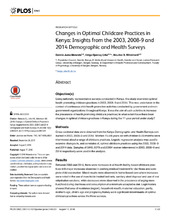| dc.description.abstract | Objective(s): Using nationally representative surveys conducted in Kenya, this study examined optimal health promoting childcare practices in 2003, 2008–9 and 2014. This was undertaken in the context of continuous child health promotion activities conducted by government and non-government organizations throughout Kenya. It was the aim of such activities to increase the prevalence of health promoting childcare practices; to what extent have there been changes in optimal childcare practices in Kenya during the 11-year period under study? Methods: Cross-sectional data were obtained from the Kenya Demographic and Health Surveys conducted in 2003, 2008–9 and 2014. Women 15–49 years old with children 0–59 months were interviewed about a range of childcare practices. Logistic regression analysis was used to examine changes in, and correlates of, optimal childcare practices using the 2003, 2008–9 and 2014 data. Samples of 5949, 6079 and 20964 women interviewed in 2003, 2008–9 and 2014 respectively were used in the analysis. Results: Between 2003 and 2014, there were increases in all health facility-based childcare practices with major increases observed in seeking medical treatment for diarrhoea and complete child vaccination. Mixed results were observed in home-based care where increases were noted in the use of insecticide treated bed nets, sanitary stool disposal and use of oral rehydration solutions, while decreases were observed in the prevalence of urging more fluid/food during diarrhoea and consumption of a minimum acceptable diet. Logit models showed that area of residence (region), household wealth, maternal education, parity, mother's age, child’s age and pregnancy history were significant determinants of optimal childcare practices across the three surveys. Conclusions: The study observed variation in the uptake of the recommended optimal childcare practices in Kenya. National, regional and local child health promotion activities, coupled with changes in society and in living conditions between 2003 and 2014, could have influenced uptake of certain recommended childcare practices in Kenya. Decreases in the prevalence of children who were offered same/more fluid/food when they had diarrhea and children who consumed the minimum acceptable diet is alarming and perhaps a red flag to stakeholders who may have focused more on health facility-based care at the expense of home-based care. Concerted efforts are needed to address the consistent inequities in the uptake of the recommended childcare practices. Such efforts should be cognizant of the underlying factors that affect childcare in Kenya, herein defined as region, household wealth, maternal education, parity, mother's age, child’s age and pregnancy history. | en_US |

